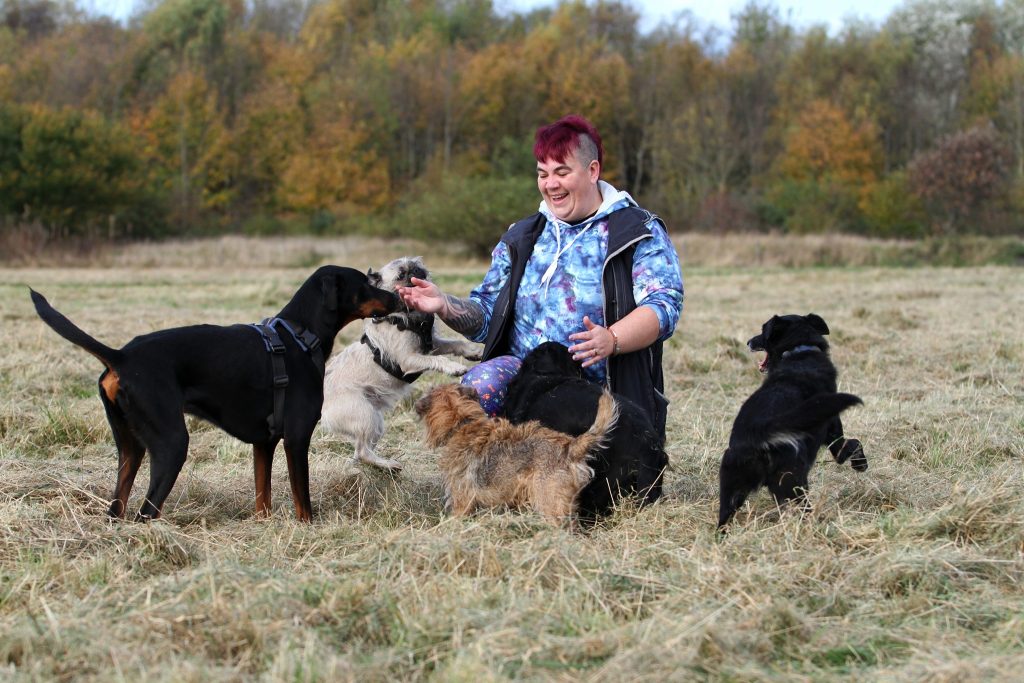The effectiveness of positive reinforcement techniques in dog training

Positive Reinforcement: The Key to Effective Dog Training
In recent years, the landscape of dog training has undergone a profound transformation, leaning increasingly towards humane methods that promote a compassionate learning atmosphere. At the forefront of these modern techniques is positive reinforcement, a strategy that involves rewarding desired behaviors to encourage their repetition. This innovative approach not only solidifies the bond between dog and owner but also enhances the overall training experience through mutual respect and understanding.
Positive reinforcement encompasses a variety of rewarding techniques, each tailored to motivate dogs effectively. Here are some commonly employed methods:
- Treat rewards: Utilizing tasty treats can provide immediate gratification for your dog when they perform the desired behavior. For instance, if you are teaching your dog to sit, offering a flavorful treat immediately after they sit will reinforce the action and increase the likelihood of them repeating it.
- Verbal praises: Dogs thrive on positive affirmation from their owners. Simple phrases like “Good boy!” or “Well done!” delivered in an enthusiastic tone can significantly enhance your dog’s confidence and encourage them to engage in the desired behaviors more frequently.
- Playtime: Many dogs are motivated by play. Incorporating their favorite toys into training sessions as a reward can make learning fun. For example, allowing a dog to fetch their ball after obeying a command not only reinforces obedience but also makes training sessions enjoyable.
Researchers have found that dogs trained with positive reinforcement tend to exhibit a greater willingness to learn and respond to commands. Furthermore, these methods promote a trusting relationship between the pet and owner, which is foundational to successful training outcomes. A dog that associates training with positive experiences is more likely to remain engaged and attentive during sessions.
However, the effectiveness of positive reinforcement can vary depending on several factors, such as:
- The dog’s age and breed: Puppies often respond particularly well to positive reinforcement because they are naturally curious and eager to please, while older dogs may take longer to unlearn old habits.
- The trainer’s consistency: For positive reinforcement techniques to be successful, consistency is crucial. Rewarding a dog inconsistently can lead to confusion and a lack of clear understanding about what behaviors are being rewarded.
- The training environment: A familiar and distraction-free setting is ideal for initial training. If the environment is too stimulating, such as during a walk in a busy park, the dog’s focus may wane, making training less effective.
As pet owners increasingly gravitate toward kinder training methods, understanding the nuances and effectiveness of positive reinforcement techniques becomes essential. While this approach holds promise for many, it challenges trainers and owners alike to adapt their strategies based on individual circumstances. With the right knowledge and commitment, positive reinforcement can lead to not only a well-trained dog but a more profound relationship grounded in understanding—creating a happier and healthier dynamic that enriches both the dog’s and owner’s life.

DISCOVER MORE: Click here to enhance your puppy’s social skills
The Science Behind Positive Reinforcement Techniques
The effectiveness of positive reinforcement techniques in dog training is supported by a growing body of scientific research. Studies have demonstrated that dogs trained using positive reinforcement are more likely to exhibit desired behaviors consistently compared to those trained with traditional aversive methods. This difference is due in part to the way dogs process rewards and motivation, revealing a fascinating interplay between behavior and psychology.
One of the foundational principles of positive reinforcement is rooted in the behaviorist theory, particularly the work of renowned psychologist B.F. Skinner. His research on operant conditioning—a method of learning that occurs through rewards—has significantly influenced modern dog training practices. The essence of positive reinforcement lies in its capacity to strengthen a behavior by providing a favorable consequence immediately following the action. This quick connection helps dogs associate specific behaviors with positive outcomes, which fosters a more engaged and responsive trainee.
Moreover, studies indicate that positive reinforcement leads to lower stress levels in dogs during training sessions. A study conducted by researchers at the University of Veterinary Medicine in Vienna found that dogs trained with positive reinforcement exhibited fewer signs of stress and anxiety than those subjected to harsh training techniques. This lower stress response not only benefits the dog’s mental health but also enhances their learning ability, as a calm dog is more likely to absorb information effectively.
Key Advantages of Positive Reinforcement Techniques
The shift towards positive reinforcement in dog training is not merely anecdotal; it is bolstered by an array of significant advantages:
- Enhanced Learning Experience: Dogs trained with positive reinforcement methods are often more engaged and motivated. This leads to faster learning as the positive consequences of their actions can spark a desire to participate during training sessions.
- Building Trust: Positive reinforcement cultivates trust between the dog and owner. This trust creates a safe environment for dogs to explore new behaviors, resulting in stronger bonds and a willingness to learn.
- Reduction of Fear-Based Behaviors: By focusing on rewarding desired behaviors rather than punishing undesired ones, trainers can minimize fear and anxiety. This approach not only makes training sessions more enjoyable but also contributes to a more balanced temperament in dogs.
- Long-Lasting Behavior Change: Positive reinforcement can lead to lasting behavioral change. When a behavior is reinforced positively, it is more likely to become ingrained, resulting in a well-mannered dog over time.
As the adoption of positive reinforcement techniques becomes more prevalent among pet owners and trainers, it is essential to remember that effectiveness hinges on the individual approach. Understanding the unique needs of each dog, along with their motivations, plays a pivotal role in optimizing training outcomes and ensuring a truly effective training journey.
| Advantages of Positive Reinforcement | Description |
|---|---|
| Enhanced Learning Speed | Dogs trained with positive reinforcement techniques learn commands and behaviors significantly faster than those subjected to punishment. |
| Stronger Bond with Owner | Using treats or praise creates trust and a stronger emotional connection between the dog and owner, leading to better overall behavior. |
| Reduced Fear and Anxiety | Training without fear of punishment helps create a calm environment, making dogs feel secure and more willing to learn. |
| Long-term Behavior Change | Positive reinforcement promotes voluntary compliance rather than obedience through fear, leading to lasting behavioral changes. |
Positive reinforcement techniques have gained popularity among dog trainers and owners alike due to their remarkable effectiveness. One core advantage is the enhanced speed of learning, as dogs tend to respond positively when rewarded for good behavior. This approach emphasizes rewarding desirable actions, which not only accelerates the learning process but also cultivates a more motivated student—your dog.Moreover, employing these techniques fosters a stronger bond between the dog and owner, as rewarding behaviors with treats or praise builds trust and affection. This emotional connection is vital for effective training, as dogs feel secure and are thus more receptive to learning.Additionally, positive reinforcement reduces fear and anxiety, creating a balanced environment where dogs feel safe to explore and learn. As a result, they are less likely to develop behavioral issues rooted in fear. Ultimately, when dogs learn through encouragement rather than punishment, it leads to long-term behavioral changes that adhere to a lifetime of good habits and a happier relationship with their human companions.
DISCOVER MORE: Click here to find helpful resources for pet adoption
Real-World Applications of Positive Reinforcement Techniques
As the scientific backing for positive reinforcement techniques in dog training continues to grow, many trainers and dog owners are witnessing practical applications that demonstrate this methodology’s effectiveness. By focusing on rewarding desired behaviors—such as sitting, staying, or coming when called—trainers can achieve significant results while enhancing the overall training experience for both the dog and handler.
A common real-world example of positive reinforcement is the use of clicker training, which is based on sound signaling. With clicker training, a trainer uses a handheld device that produces a distinct clicking noise to mark the precise moment a dog performs a desired action. The click is followed by a reward, reinforcing the connection between the click sound and the positive outcome of receiving a treat or praise. This clear and immediate feedback leads to quicker learning, as dogs grasp the correlation between their behavior and its consequence.
In practical scenarios, positive reinforcement can be particularly beneficial for addressing behavioral issues that might arise in a dog’s development. For instance, many dog owners struggle with their pets’ excessive barking. Instead of reprimanding the dog when it barks, trainers might reward the dog for being quiet. Over time, the dog learns that silence leads to positive reinforcement, effectively reducing unnecessary barking behaviors.
Training Environments and Successful Outcomes
The effectiveness of positive reinforcement extends beyond mere behavioral correction; it fosters a more enriching training environment. Dog training classes adopting these humane methods report higher retention rates among trainees. According to the American Kennel Club, dogs trained with positive reinforcement are not only more obedient but also demonstrate improved socialization skills with both humans and other dogs. This positive experience is crucial for puppy classes, where social interaction plays a vital role in developmental learning.
Additionally, successful outcomes can often be observed in therapy and service dogs trained using positive reinforcement. These dogs are among the most well-behaved and adaptable. Trainers utilize this technique to help them fulfill their roles effectively, whether as support animals for individuals with disabilities or as comfort companions in therapeutic settings. The careful use of rewards ensures that these dogs are motivated and responsive, providing indispensable assistance while remaining calm and composed in various environments.
The Role of Ownership and Engagement
The aspect of ownership and engagement cannot be overlooked when discussing the effectiveness of positive reinforcement. Studies suggest that owners who actively participate in the training process—from understanding the principles behind positive reinforcement to implementing them at home—experience more fruitful outcomes. By building a routine that emphasizes rewarding good behavior consistently, owners contribute to their dog’s learning experience and strengthen the bond between them.
Moreover, the age-old adage, “a tired dog is a happy dog,” has merit here. Engaging dogs in training activities that utilize positive reinforcement not only stimulates their minds but also encourages physical exercise. This combination of mental stimulation and physical exertion creates well-rounded dogs who are less likely to develop problematic behaviors linked to boredom or excess energy.
As awareness grows, many trainers are continuously experimenting with innovative ways to implement positive reinforcement techniques. They explore new rewards, vary training environments, and utilize advanced behavioral science to adapt their methods, ensuring they meet the evolving needs of both the dogs and their owners. The versatility and effectiveness of positive reinforcement techniques in dog training signify a shift toward more humane, engaging, and lasting impacts in the realm of canine behavior modification.
DISCOVER MORE: Click here to learn how to choose the perfect pet
Conclusion: Embracing Positive Reinforcement in Dog Training
In summary, the effectiveness of positive reinforcement techniques in dog training is both scientifically supported and demonstrably beneficial in real-world scenarios. By focusing on rewarding desirable behaviors, trainers not only expedite the learning process but also cultivate a nurturing environment that strengthens the bond between dogs and their owners. This method is particularly effective in addressing common behavioral challenges; for instance, transforming excessive barking into moments of tranquility through strategic rewards enhances the overall training experience.
Additionally, the proven success of positive reinforcement in various settings—such as therapy and service dog training—illustrates its capacity to produce reliable, well-adjusted animals capable of fulfilling essential roles in society. The emphasis on engagement and owner participation further underscores the integral role that active involvement plays in training outcomes. As owners adopt a consistent approach that encourages good behavior, they contribute significantly to their dog’s ongoing development.
As we move forward, the exploration of innovative rewards and training methods highlights a promising future for dog training that prioritizes humane treatment and effective behavioral modification. As dog owners and trainers continue to embrace the principles of positive reinforcement, we can expect a transformative impact on the relationship between humans and their canine companions. With an ever-growing body of research affirming these techniques, the path ahead is clear: fostering kindness and encouragement will yield the happiest, most obedient dogs—benefiting both the pets and their loving families.


